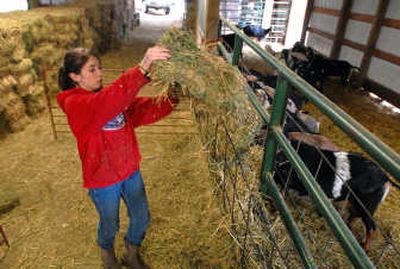For the love of the goats

Heather Janke and her husband, Keith, have been raising goats in earnest at KnH Ranch outside of Cheney for about six years now. Before that time the animals were just pets. And before the goats’ arrival, the Jankes were unaware of their quirky nature.
“My sister took a job in Belgium, and she begged me to take these two little La Mancha goats that she had,” says Janke. “I thought, ‘Well, the kids could show them at the fair, that’ll be fun.’ Because I always did horses. Horses were my thing. But those two little goats just stole our hearts. They’re very similar to dogs. They’re very companion-oriented. So then it became serious after that.”
KnH Ranch specializes in purebred LaMancha and Nubian milk goats, as well as full-blood and percentage Boer goats, the latter meaning not a purebred, generally a cross between a dairy doe and a Boer buck. This combination produces more milk than a purebred.
There are other differences between the breeds. La Mancha goats are bred for temperament and milk quality. They have a lot of personality, and very small ears, which never fails to elicit comments.
“Everybody asks me every year at the fair if I cut them off. Or if they froze off,” says Janke. “I even have a big sign up on my display that explains the ears and I still get asked at least 100 times a day. But that’s how they’re born.” Most people are more familiar with the Nubians, with their appealing long, floppy ears. Although quite docile, these goats scream frequently – for attention, to be milked, or just for fun.
Both La Mancha and Nubian goats have the highest percentage of butterfat and sweet milk qualities. Other kinds of goats may produce more quantity, but Janke doesn’t think their milk tastes as good. And to be fair, she did try all seven of the dairy breeds.
“We had every breed there is in the beginning,” says Janke. “We tried them all, because I thought, ‘Well, I’m not going to be biased. I’m not going to go by other people’s opinions.’ Because I really wanted to try it myself and see.”
It’s a weight factor rather than age that determines when the dairy goats can produce milk. They must be close to 100 pounds, which usually occurs by the time they are a year old. The taste of the milk depends on the goats’ fare. Janke feeds them a very specialized diet of alfalfa grass mix that is high in protein, minerals and whole grains. This creates sweet milk. If they forage on weeds then the milk becomes bitter. Plenty of water is important. The milk also must be chilled immediately or it will be strong.
Her family drinks only goats’ milk. Janke sometimes makes goat cheese as well; the Mexican soft white kind called Queso Blanco. Her dream is to one day have a Grade A dairy, but her husband is not keen on the idea.
“So I will continue to provide the animals I have at the level that I have,” says Janke. “I’m going to keep my operation at the level it is for now because that’s what we can manage. Hopefully it will be a business that we can grow into at retirement age. Say at 55, we might be able to do this as our full-time business.”
The Boer goats are raised for meat only. Of the four meat breeds Janke chose Boer, as they are the most docile. She did not care for the Alpines, claiming they have ‘attitude.’ The taste is similar to venison, as they are of the same order as deer.
A few of the goats are raised for show only, and very few as pets – ones that are too old, or have sentimental value. Whatever their service, they all require extensive care. It takes Janke four hours a day to feed and milk the goats, in addition to her regular full-time job.
“It’s got to be a joy, or it would be just work,” says Janke. “So I tell people that you’ve really got to love doing this, or you wouldn’t do it, because it is a lot of work.”